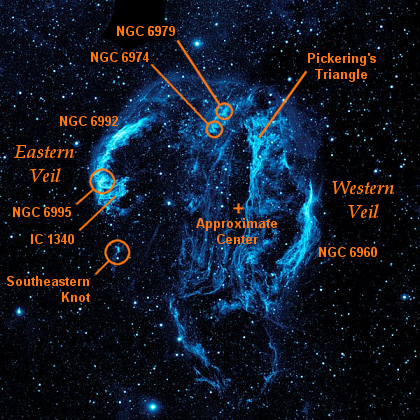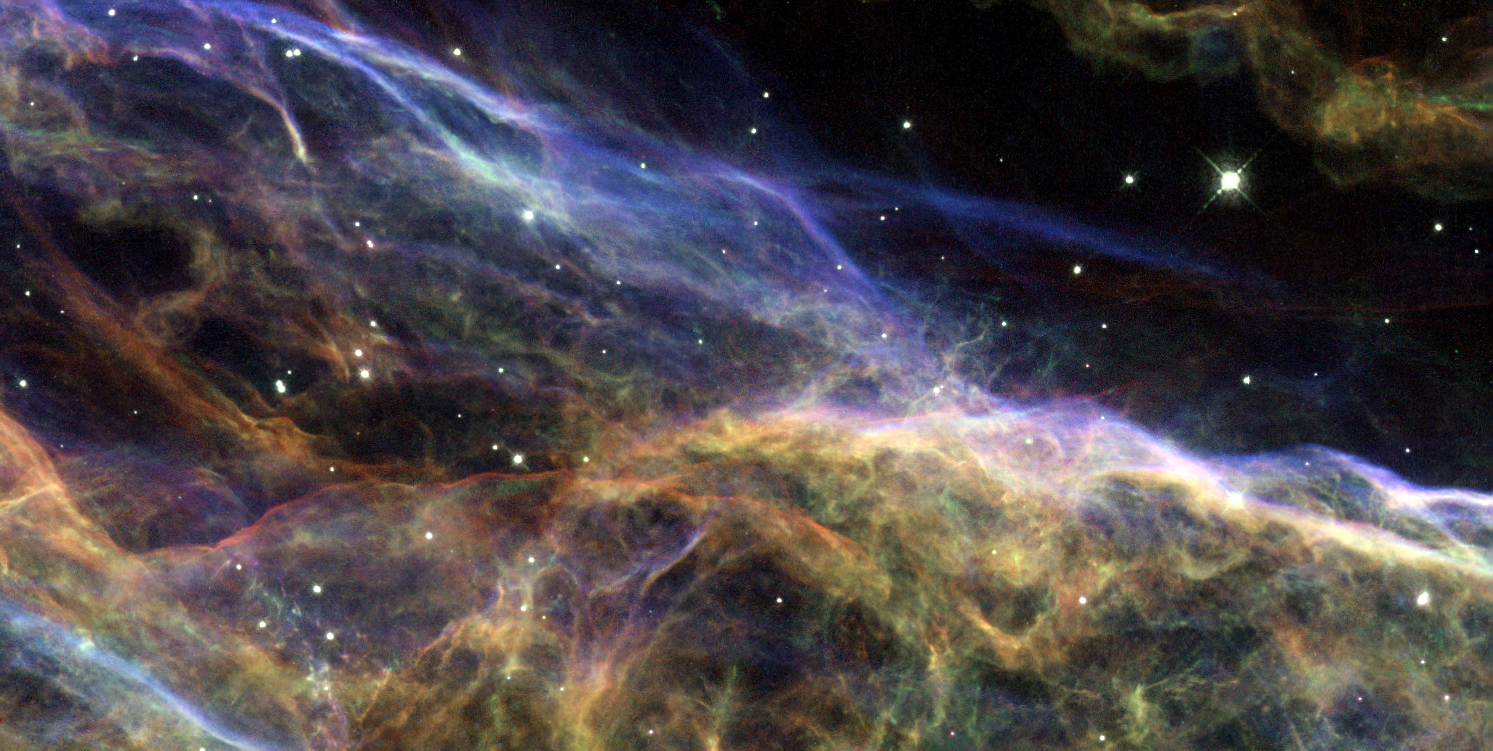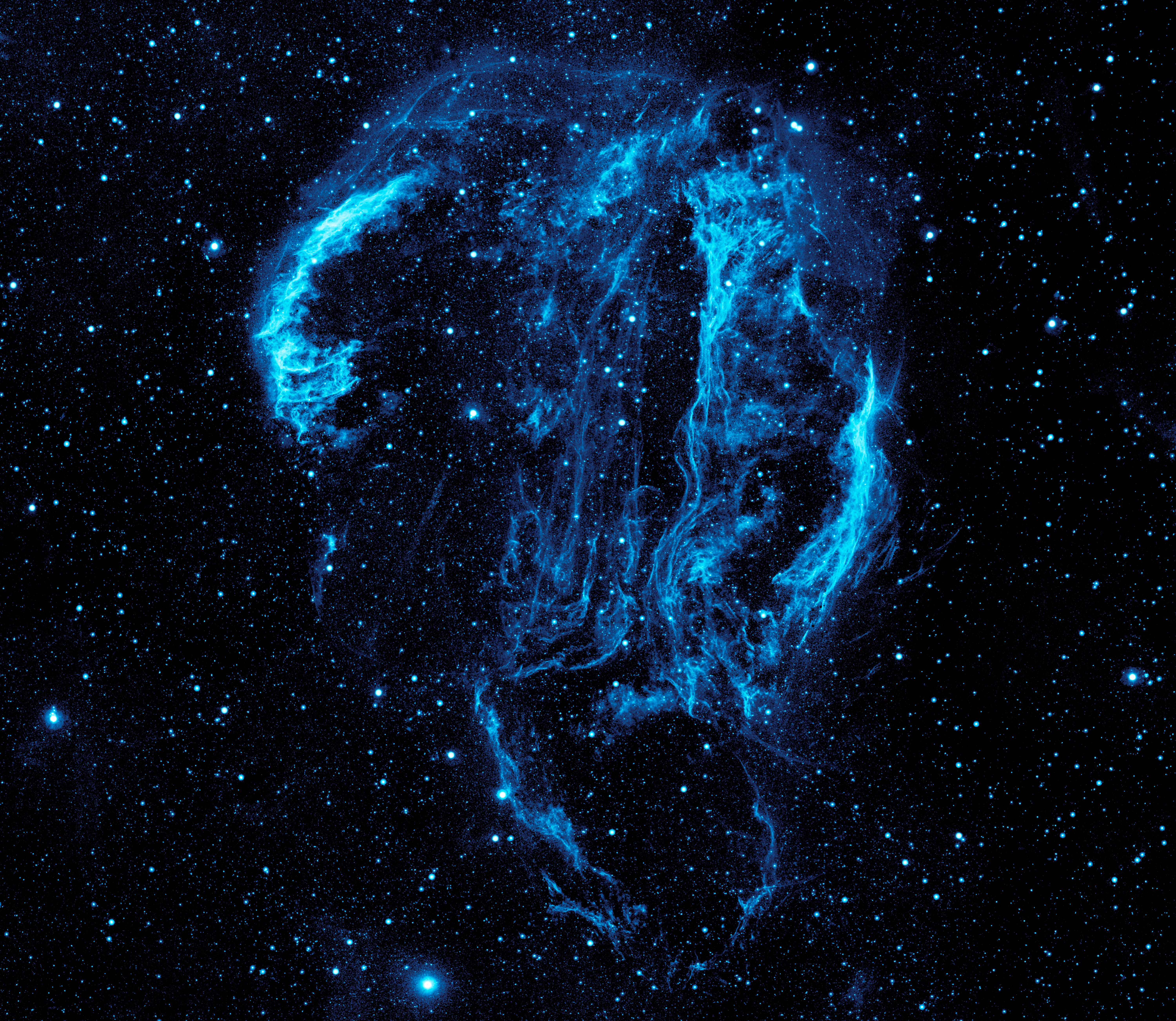Cygnus Loop on:
[Wikipedia]
[Google]
[Amazon]
 The Cygnus Loop (radio source W78, or Sharpless 103) is a large supernova remnant (SNR) in the
The Cygnus Loop (radio source W78, or Sharpless 103) is a large supernova remnant (SNR) in the



 The visual portion of the Cygnus Loop is known as the Veil Nebula, also called the Cirrus Nebula or the Filamentary Nebula. Several components have separate names and identifiers, including the "Western Veil" or "Witch's Broom", the "Eastern Veil", and Pickering's Triangle.
The visual portion of the Cygnus Loop is known as the Veil Nebula, also called the Cirrus Nebula or the Filamentary Nebula. Several components have separate names and identifiers, including the "Western Veil" or "Witch's Broom", the "Eastern Veil", and Pickering's Triangle.
this photo
posted by ''Astronomy Magazine'' (accessed 2010-12-01). but the Triangle is probably not what Herschel saw or what the Catalogue intended for this entry: it was discovered only photographically, after the Catalogue was published, and long after Herschel's observation. NGC 6974 was reported by
 The brightest far-ultraviolet sources of the Cygnus Loop occur in the north-east edge of the remnant. The first flight of the High Resolution Emission Line Spectrometer (HIRELS), a wide-field, far-ultraviolet nebular spectrometer, tuned to OVI emission lines, was launched aboard a Nike-Black Brant from White Sands Missile Range to observe the Cygnus Loop, the first observed galactic OVI emission line source.
The brightest far-ultraviolet sources of the Cygnus Loop occur in the north-east edge of the remnant. The first flight of the High Resolution Emission Line Spectrometer (HIRELS), a wide-field, far-ultraviolet nebular spectrometer, tuned to OVI emission lines, was launched aboard a Nike-Black Brant from White Sands Missile Range to observe the Cygnus Loop, the first observed galactic OVI emission line source.
Sharpless Catalog 103
* *
image from NOAO
in one of the largest astronomical images yet made
(universetoday.com).
The loop at 1420 mhz
{{Cygnus (constellation) Supernova remnants X-ray astronomy Astronomical X-ray sources Cygnus (constellation) Sharpless objects
 The Cygnus Loop (radio source W78, or Sharpless 103) is a large supernova remnant (SNR) in the
The Cygnus Loop (radio source W78, or Sharpless 103) is a large supernova remnant (SNR) in the constellation
A constellation is an area on the celestial sphere in which a group of visible stars forms Asterism (astronomy), a perceived pattern or outline, typically representing an animal, mythological subject, or inanimate object.
The origins of the e ...
Cygnus, an emission nebula measuring nearly 3° across. Some arcs of the loop, known collectively as the Veil Nebula or Cirrus Nebula, emit in the visible electromagnetic range. Radio, infrared, and X-ray images reveal the complete loop.
Visual components: the Veil Nebula



 The visual portion of the Cygnus Loop is known as the Veil Nebula, also called the Cirrus Nebula or the Filamentary Nebula. Several components have separate names and identifiers, including the "Western Veil" or "Witch's Broom", the "Eastern Veil", and Pickering's Triangle.
The visual portion of the Cygnus Loop is known as the Veil Nebula, also called the Cirrus Nebula or the Filamentary Nebula. Several components have separate names and identifiers, including the "Western Veil" or "Witch's Broom", the "Eastern Veil", and Pickering's Triangle.
NGC 6960
NGC 6960, the ''Western Veil'', is the western part of the remnant, also known as the "Witch's Broom", located at J2000 RA Dec . As the westernmost NGC object in the nebula (first inright ascension
Right ascension (abbreviated RA; symbol ) is the angular distance of a particular point measured eastward along the celestial equator from the Sun at the March equinox to the (hour circle of the) point in question above the earth.
When paired w ...
), its number is sometimes used as an NGC identifier for the nebula as a whole.
NGC 6992, NGC 6995, and IC 1340
These three luminous areas make up the ''Eastern Veil''. NGC 6992 is an HI shell located along the north-eastern edge of the loop at J2000 RA Dec . NGC 6995 is located farther south at J2000 RA Dec , and IC 1340 even farther south at J2000 RA Dec .Pickering's Triangle
Also known as Pickering's Wedge, or Pickering's Triangular Wisp, this segment of relatively faint nebulosity was discovered photographically in 1904 byWilliamina Fleming
(15 May 1857 – 21 May 1911) was a Scottish-American astronomer. She was a single mother, hired by the director of the Harvard College Observatory to help in the photographic classification of stellar spectra. She helped develop a common d ...
at Harvard Observatory, where Edward Charles Pickering was director at the time. The Triangle is brightest along the northern side of the loop, though photographs show the nebulosity extending into the central area as well.
NGC 6974 and NGC 6979
These two objects are generally identified today (as by the NGC/IC Project and ''Uranometria'') with two brighter knots of nebulosity in a cloud at the northern edge of the loop, to the east of the northern edge of Pickering's Triangle. NGC 6979 was reported by William Herschel, and while the coordinates he recorded for Veil objects were somewhat imprecise, his position for this one is tolerably close to the knot at J2000 RA Dec . The identifier ''NGC 6979'' is sometimes taken to refer to Pickering's Triangle,See, for examplethis photo
posted by ''Astronomy Magazine'' (accessed 2010-12-01). but the Triangle is probably not what Herschel saw or what the Catalogue intended for this entry: it was discovered only photographically, after the Catalogue was published, and long after Herschel's observation. NGC 6974 was reported by
Lord Rosse
William Parsons, 3rd Earl of Rosse (17 June 1800 – 31 October 1867), was an Irish astronomer, naturalist, and engineer. He was president of the Royal Society (UK), the most important association of naturalists in the world in the nineteenth ...
, but the position he gave lies in an empty region inside the main loop. It was assumed that he recorded the position incorrectly, and the New General Catalogue
The ''New General Catalogue of Nebulae and Clusters of Stars'' (abbreviated NGC) is an astronomical catalogue of deep-sky objects compiled by John Louis Emil Dreyer in 1888. The NGC contains 7,840 objects, including galaxies, star clusters and ...
gives Rosse's object as the other knot in the northern cloud, located at J2000 RA Dec , one degree north of Rosse's position. (This position is farther east than NGC 6979, even though NGC objects are generally ordered by increasing RA.) These filaments in the north-central area are sometimes known as the "carrot". The spectrum at 34.5 MHz of the region associated with NGC 6974 ranges straight over the entire frequency range 25 to 5000 MHz.
Southeastern knot
The southeastern knot is located at J2000 RA Dec on the southeastern rim of the Cygnus Loop. The knot has been identified as an encounter between the blast wave from the supernova and a small isolated cloud. The knot is a prominent X-ray feature, consisting of a number of filaments correlated with visual line emission. By combining visual and X-ray data, it can be shown that the southeastern knot is an indentation on the surface of the blast wave, not a small cloud but the tip of a larger cloud. The presence of a reverse shock is evidence that the knot represents an early stage of a blast wave encountering a large cloud.Distance
Until 1999, the most often-quoted distance to the supernova remnant was a 1958 estimate made by R. Minkowski, combining his radial velocity measurements with E. Hubble's proper motion study of the remnant's optical filaments to calculate a distance of 770 parsecs or 2500 light-years. However, in 1999, William Blair, assuming that the shock wave should be expanding at the same rate in all directions, compared the angular expansion along the sides of the bubble (visible in Hubble Space Telescope images) with direct line-of-sight measurements of the radial expansion towards the Earth and concluded that the actual size of the bubble was about 40% smaller than the conventional value, leading to a distance of about 1470 ly. A larger revised value of 540 pc (1760 ly) appeared to be corroborated by Blair's later discovery, via the Far Ultraviolet Spectroscopic Explorer (FUSE), of a star seemingly ''behind'' the Veil. A UV spectrum of this star, KPD 2055+3111 of spectral type sdOB, showed absorption lines in its spectrum indicate that its light is partially intercepted by the supernova remnant. With an estimated (but uncertain) distance of about 1860 ly away, this star seemed to support the revised estimate of 1760 ly. More recent investigations of the Cygnus Loop's distance using ''Gaia
In Greek mythology, Gaia (; from Ancient Greek , a poetical form of , 'land' or 'earth'),, , . also spelled Gaea , is the personification of the Earth and one of the Greek primordial deities. Gaia is the ancestral mother—sometimes parthenog ...
'' parallax measurements of several stars seen toward the Cygnus Loop have led to more accurate distance estimates. One of these stars, a 9.6 magnitude B8 star (BD+31 4224) located near the remnant's northwestern rim shows evidence of interactions of its stellar wind with the Cygnus Loop's shock wave, thereby indicating it is located actually inside the remnant. This star's Gaia estimated distance of around 730 pc, along with two other stars both at about 740 pc which exhibit spectral features indicating they must lie behind the remnant, leads to new distance of 725 15 pc or around 2400 light-years. The Gaia estimated distance to the sdOB star KPD 2055+3111 is 819 pc (2,670 ly). This new distance, surprisingly close to the value estimated some 60 years ago by Minkowski, means the Cygnus Loop is physically some 37 pc (120 ly) in diameter and has an age of around 20,000 years.
Astronomical ultraviolet source
 The brightest far-ultraviolet sources of the Cygnus Loop occur in the north-east edge of the remnant. The first flight of the High Resolution Emission Line Spectrometer (HIRELS), a wide-field, far-ultraviolet nebular spectrometer, tuned to OVI emission lines, was launched aboard a Nike-Black Brant from White Sands Missile Range to observe the Cygnus Loop, the first observed galactic OVI emission line source.
The brightest far-ultraviolet sources of the Cygnus Loop occur in the north-east edge of the remnant. The first flight of the High Resolution Emission Line Spectrometer (HIRELS), a wide-field, far-ultraviolet nebular spectrometer, tuned to OVI emission lines, was launched aboard a Nike-Black Brant from White Sands Missile Range to observe the Cygnus Loop, the first observed galactic OVI emission line source.
X-ray source
The X-ray source Cygnus X-5 coincides with SNR G074.0-08.6 (the Cygnus Loop), located at J2000 RA Dec , observed by Uhuru at 4U 2046+31. This source also has catalogue numbers 1E 2049.4+3050, 1H 2050+310, and 1M 2051+309, having been observed by theEinstein Observatory
Einstein Observatory (HEAO-2) was the first fully imaging X-ray telescope put into space and the second of NASA's three High Energy Astrophysical Observatories. Named HEAO B before launch, the observatory's name was changed to honor Albert E ...
, HEAO 1, and OSO 7
OSO 7 or Orbiting Solar Observatory 7 (NSSDC ID: 1971-083A), before launch known as OSO H is the seventh in the series of American Orbiting Solar Observatory satellites launched by NASA between 1962 and 1975. OSO 7 was launched from Cape Kennedy ...
, respectively.
The Cygnus Loop is a strong source of soft X-rays.
The center of the supernova shell as determined from X-ray data lies at J1950 RA Dec . A characteristic thermal temperature averaged over the loop from X-ray spectral data is Tx = 2.9 ± 1.5 x 106 K. An X-ray surface brightness map of the loop was obtained with a one-dimensional X-ray telescope flown aboard an Aerobee 170 sounding rocket
A sounding rocket or rocketsonde, sometimes called a research rocket or a suborbital rocket, is an instrument-carrying rocket designed to take measurements and perform scientific experiments during its sub-orbital flight. The rockets are used to ...
launched on March 30, 1973, from the White Sands Missile Range.
Searches for a compact stellar remnant
Most stars that produce supernovae leave behind compact stellar remnants- a neutron star orblack hole
A black hole is a region of spacetime where gravitation, gravity is so strong that nothing, including light or other Electromagnetic radiation, electromagnetic waves, has enough energy to escape it. The theory of general relativity predicts t ...
, typically depending on the mass of the original star. Various techniques based on the features of the supernova remnant estimate the Cygnus Loop progenitor star's mass at 12 to 15 Solar mass
The solar mass () is a standard unit of mass in astronomy, equal to approximately . It is often used to indicate the masses of other stars, as well as stellar clusters, nebulae, galaxies and black holes. It is approximately equal to the mass ...
es, a value that puts the expected remnant firmly within neutron star boundaries. However, despite many searches, no compact stellar remnant had been confidently identified since the identification of the supernova remnant.
A noted anomaly is that in X-rays, the nebula appears perfectly spherical aside from a "blowout region" to the south. Searches for a compact stellar remnant have been largely concentrated here, as the hole may have been caused by the violent ejection of a neutron star. A detailed 2012 study of the blowout region identified a possible pulsar wind nebula, as well as a point-like source within it. Although at almost exactly the same position as a known Seyfert galaxy
Seyfert galaxies are one of the two largest groups of active galaxies, along with quasars. They have quasar-like nuclei (very luminous, distant and bright sources of electromagnetic radiation) with very high surface brightnesses whose spectra ...
, the slight offset combined with a lack of a radio counterpart makes the point-like source probably unrelated to the galaxy. Whether the feature is a pulsar wind nebula, and if so whether it is related to the Cygnus Loop, is still unknown for certain. If it is indeed the compact stellar remnant of the supernova, the neutron star would have to have been ejected from the center of the nebula at a speed of roughly , depending on the precise age and distance of the remnant.
Fiction
In the novel '' Mindbridge'' by Joe Haldeman, the Cygnus Loop is the remains of the home star of an omnipotent, immortal race that ultimately decided to destroy itself.See also
* X-ray astronomy * Radio astronomy * Ultraviolet astronomyReferences
External links
Sharpless Catalog 103
* *
image from NOAO
in one of the largest astronomical images yet made
(universetoday.com).
{{Cygnus (constellation) Supernova remnants X-ray astronomy Astronomical X-ray sources Cygnus (constellation) Sharpless objects